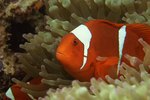The bowfin is an elongated, cylindrical fish inhabiting slow moving backwaters in North America. It is hence also called by names such as “mudfish,” “cypress trout,” “dogfish,” “black fish” and “grindle” or “grinnel.” The “grinnel” is not a separate species, but simply another name for the bowfin. This species is found around the Florida peninsula, the Mississippi basin and along the Gulf Coast, where it eats other fish, amphibians, insects and crayfish. The bowfish or grinnel possesses certain characteristics, making it possible to distinguish it from other fish.
Anatomy
These fish have a particularly long back or dorsal fin. The American eel is the only other fish from Alabama with a longer dorsal fin. The bowfin possesses cycloid scales covering their body, but a scaleless head, which contains two barbels. The bowfin has a bony plate that lies between the underside of its head and its bottom jaw. The bowfin’s back has an olive green to brown color, while its ventral surface is much lighter, grading from a light green to cream. The bowfin’s caudal or tail fin appears to be circular and possesses a single lobe. The bowfin’s mouth contains numerous sharp teeth. This species can weigh up to 15 pounds and can grow to a length of 3 feet.
Coloration
Mature male bowfins and young individuals of both sexes possess a false eye marking near their caudal fin. This dark marking, which is surrounded by a ring of either orange or yellow color, draws the attention of a predator to the tail area of the fish. Predator fish swallow their prey head first and while this hunter is concentrating on the tail eye-spot marking, the bowfin can escape by swimming away in the opposite direction.
Reproduction
This species spawns in weed beds during spring. The male fish uses roots to create a round nest that can be up to 3 feet in diameter. The male spawns with more than one female and guards the young fry until they are roughly 4 inches long. These young bowfins follow their father, who protects them from predators. During this time, the young fish remain in a tight group or school, but separate after they leave the care of the male.
Ancient Species
The bowfin is a primitive fish species, which lived during the Jurassic period. It is the only surviving member from an order which has otherwise become extinct. Other species in this order are known only through fossils, which have been dated to the Cretaceous, Eocene and Jurassic periods.
References
Photo Credits
-
Stockbyte/Stockbyte/Getty Images
Writer Bio
Virtually growing up in a computer repair shop, Naomi Bolton has held a passion for as long as she can remember. After earning a diploma through a four year course in graphic design from Cibap College, Bolton launched her own photography business. Her work has been featured on Blinklist, Gameramble and many others.




